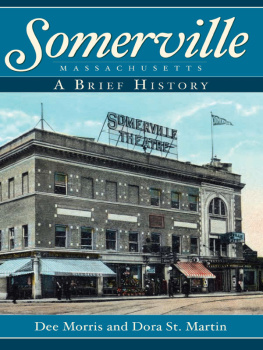


Published by The History Press
Charleston, SC 29403
www.historypress.net
Copyright 2008 by Dee Morris and Dora St. Martin
All rights reserved
Cover image: Postcard, Somerville Theatre, 1914.
All images are courtesy of the authors unless otherwise noted.
First published 2008
e-book edition 2013
Manufactured in the United Kingdom
ISBN 978.1.62584.357.9
Library of Congress Cataloging-in-Publication Data
Morris, Dee.
Somerville : a brief history / Dee Morris and Dora St. Martin.
p. cm.
Includes bibliographical references and index.
print edition ISBN 978-1-59629-424-0
1. Somerville (Mass.)--History. I. St. Martin, Dora. II. Title.
F74.S7M67 2008
974.44--dc22
2008019189
Notice: The information in this book is true and complete to the best of our knowledge. It is offered without guarantee on the part of the author or The History Press. The author and The History Press disclaim all liability in connection with the use of this book.
All rights reserved. No part of this book may be reproduced or transmitted in any form whatsoever without prior written permission from the publisher except in the case of brief quotations embodied in critical articles and reviews.
But there are cities that are still dear to us above all others, because they are what I may call cities of the heart. There we are born, there we have lived, there our little lot in life was cast, there is the spot where our fortunes or our characters have been nurturedand the scenes amid which have sprung up some of the tenderest and most sacred ties. To most of us Somerville is such a spot.
Reverend William H. Pierson, 1892
Somerville doesnt have to tip its hat to anybody in the country as far as history goes. Were older than Boston, and our history dwarfs Cambridge. Somerville is a tiny city geographically but a big city when it comes to population. That adds up to a lot of stories.
Bob Monty Doherty, of the Somerville Fire Department, 2007
Contents
Acknowledgements
We would like to thank those who helped us in their professional capacities: Kevin OKelly, Ron Castile and the staff of the Somerville Public Library; Jeanne Gamble of Historic New England; and the staff of the Boston Public Library.
We would like to thank individuals for their kindness in loaning us family photographs, personal artwork and stories: Joanne Cook, Ed Dente, Bob Monty Doherty, Charlie McCarthy, the families of Maynard and Laverne Bachelder and Marie (Marchi) Bonello and past and present members of the Somerville Historical Society.
We would like to thank our family and friends, especially Joleen and Laura Collins, Karen Hohler and Alonzo and Sarah Eliot for their good-natured encouragement and support.
Finally, we would like to thank John Martin for his technical expertise and support, without whom this book would not look so pretty.
Introduction
Somerville is 4.2 square miles of hills, neighborhoods and people. It is a place where the concept of community is vital, yet individuality is treasured. Somerville is constantly changing and is always in a state of becoming. Next door to Boston, it is a natural gateway used by countless generations as a convenient place to live. But the citys fluid nature cannot be explained away so easily. We discovered some of its complexity and contradictions as we put together educational and historical programs.
Making history come alive is always a challenge. In our many Victorian walking tours of Somerville, we have had the joy of introducing our contemporaries to their neighbors from the past. As we learned about these former residents, we were amazed at their drive to improve their lives and to take responsibility for their community. We have found, paraphrasing Shakespeare, that some were born great, some achieved greatness and some had greatness thrust upon them. They changed the expectations for themselves and, as a result, changed a city.
Our book flows chronologically through the eyes of these Victorianslooking back to the Revolutionary past, yet daring to embrace a future filled with new inventions. It is not history in a straight line. Somervilles hills act as bookmarks to represent key times, events and directions in the citys history:
Ten Hills Farm, home to the earliest settlers and the states first governor;
Cobble Hill, where General Putnam placed his cannon during the siege of Boston and later McLean Asylum for the Insane;
Ploughed Hill (also called Mount Benedict), where religion and race played out in the burning of the Ursuline Convent;
Middle Hill (also known as Central Hill), named because it stands in the center of the other prominences, but is also core to Somervilles civic life;
Winter Hill, once crowned with elegant mansions and later home to a streetcar suburb and a growing merchant class;
elegant Spring Hill, where women found their voices;
Prospect Hill and Union Square, where the flying of the first flag made history and inspired a generation of writers;

Workmen construct Washington Street while admiring citizens look on. Somerville Annual Report, 1901.

Workmen spread asphalt on Cross Street. Somerville Annual Report, 1901.
Clarendon and Wild Cat Hills, bordering Cambridge and last to be developed, playing host to a Civil War camp and Somervilles African American community;
Quarry and Walnut Hill, now called College Hill, on which stand the buildings of Tufts College, partly in Somerville and partly in Medford; and
Strawberry Hill and Davis Square, where beauty and art met at the crossroads.
Somerville was first settled in 1630 as a part of Charlestown. At the time of the Revolutionary War, the population was no more than 250, with no more than thirty houses along Cambridge, Winter Hill and Milk Row (Somerville Avenue) roads. Winter, Prospect, Spring, Middle and Walnut Hills were pasturelands, and north of Winter Hill, fields stretched out to the marshes adjacent to the Mystic River.
Separating from Charlestown in 1842, the city was left with few roads, some schoolhouses, a pound and an inadequate fire engine. Not put off by this meager dowry, these early residents were determined to improve their rural landscape. Their answer to progress for their community was to build, build, build! Led by the new merchant class and real estate operatives, old farms and estates were divided and soldsubdivided again and again, quickly erasing traces of what went before. Good transportation, coupled with great publicity, encouraged growth, making it one of the most densely populated communities in the nation. Lots of great people. Lots of great stories. Enjoy.
Chapter 1
Ten Hills
BECOMING SETTLED
PEACE FOR LAND
It is very beautiful in open lands, mixed goodly woods, and again open plainsno place barren but on the tops of the hills. The grass and weeds grow up to a mans face in the lowlands, and by fresh rivers abundance of grass and large meadows. Alewife Brook teemed with fish and the Mystic River was plentifully supplied with smelt.
Next page
















